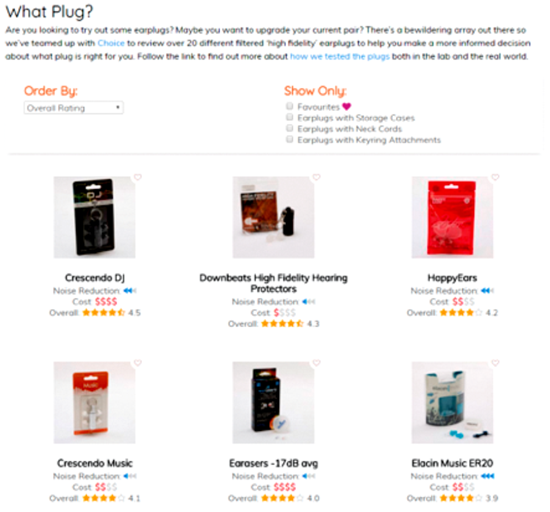For decades, audiologists have encouraged people to wear hearing protection when they attend concerts. Traditionally, the most accessible options have been foam plugs, which have limited appeal due to their poor sound quality.
Disposable foam plugs absorb high frequency sounds more than low frequency sounds, resulting in music that sounds muffled with poor speech clarity. Conversely, high fidelity earplugs attenuate sound evenly across frequencies, preserving the original music sound quality but at a reduced volume. As a result, high fidelity earplugs are associated with better music sound quality compared with disposable foam plugs.
Today there are many options for high fidelity reusable earplugs available on the market but choosing the right ones can be difficult. ‘What Plug?’ is a subsection of ‘HEARsmart’, a hearing loss prevention website based out of Australia (http://hearsmart.org). ‘What Plug?’ offers reviews of 20 high fidelity plugs on an interactive web page. Each plug has been tested in both a laboratory setting for its attenuation properties and also in real-life at music venues.
For each plug reviewed within ‘What Plug?’ attenuation properties were tested by over 20 participants. The test subjects had to fit the earplugs using only the package instructions (i.e. no professional assistance) in order to best reflect the effectiveness of the plugs by an average person. The plugs were then placed in one of three attenuation categories based on their numerical SLC80 (Sound Level Conversion valid for 80% of wearers) rating: low (0-7), medium (8-10), or high (11-14) attenuation.

While the ‘What Plug?’ page is a great starting point for anyone interested in purchasing high fidelity earplugs, it unfortunately does not include guidance for how much attenuation is likely required in different situations (e.g. whether low attenuation would be enough for a rock concert) to help people decide which plug is most appropriate for their specific needs. Thankfully, this type of information can be accessed in other sections of the website (e.g. ‘Know Your Noise’).
Users can additionally choose to have the plugs displayed according to how they rank in various categories (e.g. comfort, appearance, sound quality, ease of conversation). For some categories, the displayed scores are averaged from real-world feedback from ‘gig goers’ who have tried at least two of the earplug varieties in music venues. While it can be helpful to see first-hand feedback from actual users, it’s worth noting that ear canal sizes and shapes can vary substantially so individual ratings of comfort and appearance may be quite subjective. Alternatively, you can select to show only the plugs with specific features (e.g. storage cases, neck cords, key ring attachments).
There is currently no option to compare the interaction of different categories (e.g. ease of conversation versus level of attenuation) to examine possible trends, though the HEARsmartteam has submitted the data they’ve collected to a peer-reviewed publication which hopefully may show such trends in the near future. When selecting a plug, users should keep in mind the potential tradeoff between the categories to best address their comfort and protection.
Overall, ‘What Plug?’ is a good resource that highlights the variety of lesser known high fidelity earplug options with both laboratory measurements and real world reviews, which hopefully will encourage more people to adopt safe listening habits. ‘What Plug?’ can be reached at: https://hearsmart.org/earplugs/what_plug/
Happy safe listening, concert goers!




